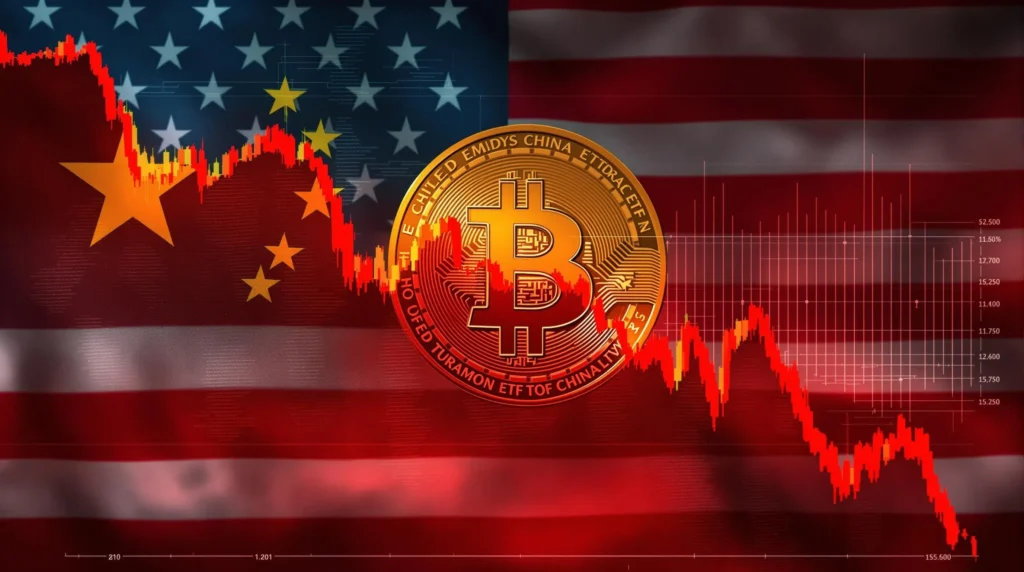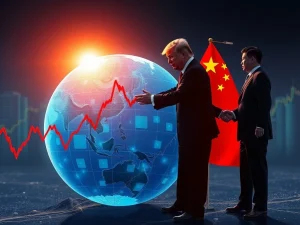Alarming $1.14 Billion Bitcoin ETF Exodus: US-China Trade War Triggers Crypto Market Jitters

Buckle up, crypto enthusiasts! The world of Bitcoin ETFs has just experienced a seismic shift. We’re talking about a whopping $1.14 billion fleeing US-based Bitcoin ETFs in just two weeks. Yes, you read that right. This isn’t just a minor dip; it’s the largest outflow since these investment vehicles first burst onto the scene. What’s behind this sudden investor exodus, and what does it mean for the future of Bitcoin and the broader crypto market? Let’s dive deep into the currents driving this market turbulence.
What’s Fueling the Bitcoin ETF Outflows?
The crypto market, known for its volatility, is currently navigating a complex web of global economic factors. The recent significant Bitcoin ETF outflows aren’t happening in a vacuum. Several interconnected elements are contributing to this downturn in investor sentiment. Let’s break down the key players:
- Escalating US-China Trade Tensions: The specter of renewed trade disputes between the US and China is casting a long shadow over global markets. Trade wars create uncertainty, impacting investor confidence across various asset classes, including cryptocurrencies. When major economies clash, risk-averse behavior tends to increase, leading investors to pull back from perceived riskier assets like Bitcoin.
- Monetary Policy Concerns: Whispers and worries about future monetary policy are adding to the unease. Central banks’ decisions on interest rates and inflation management directly influence investment strategies. If investors anticipate tighter monetary policies – potentially higher interest rates – they might become less inclined to hold assets like Bitcoin, which doesn’t offer yield in the traditional sense, and instead favor interest-bearing assets.
- Overall Market Sentiment: Beyond specific events, the general mood in the market plays a crucial role. A negative shift in overall market sentiment, often influenced by macroeconomic news and geopolitical events, can trigger widespread sell-offs. Fear and uncertainty are contagious, and when investors collectively become cautious, assets like Bitcoin, despite their long-term potential, can face immediate selling pressure.
Decoding the $1.14 Billion Bitcoin ETF Exodus: What Do the Numbers Tell Us?
Let’s put that $1.14 billion Bitcoin ETF outflows figure into perspective. This isn’t just pocket change; it’s a substantial amount of capital leaving these investment vehicles. To understand the magnitude, consider these points:
- Largest Outflow Since Launch: This two-week period marks the most significant outflow since US Bitcoin ETFs were introduced. This highlights a potentially critical shift in investor behavior, as previous dips were less pronounced.
- Impact on ETF Performance: Such large outflows can put downward pressure on the price of Bitcoin itself, as ETF providers may need to sell off Bitcoin holdings to meet redemption requests. This creates a negative feedback loop, potentially exacerbating market declines.
- Investor Confidence Indicator: ETF outflows are often seen as a barometer of investor confidence. Significant outflows can signal a broader lack of conviction in the near-term prospects of Bitcoin and the crypto market. It suggests that investors are choosing to de-risk their portfolios amidst the prevailing uncertainties.
To visualize the scale, imagine a table comparing these outflows to previous periods (though specific data for comparison isn’t provided in the prompt, this would be valuable in a real article):
Bitcoin ETF Outflow Comparison (Hypothetical)
| Period | Outflow Amount | Significance |
|---|---|---|
| Last 2 Weeks | $1.14 Billion | Largest outflow since launch |
| Previous 2 Weeks | ~$500 Million (Hypothetical) | Significant, but less than current |
| Average Weekly Outflow (Past Month) | ~$300 Million (Hypothetical) | Below recent surge |
Note: This table uses hypothetical data for illustrative purposes only. Real-world data would be needed for an accurate comparison.
US-China Trade War and Crypto: An Unexpected Connection?
You might be wondering, what does a potential US-China trade war have to do with Bitcoin ETFs? The connection, while not always direct, is significant in today’s interconnected global economy. Here’s how trade tensions can ripple through to the crypto market:
- Global Economic Uncertainty: Trade wars inject uncertainty into the global economic outlook. Businesses and investors become hesitant when trade relationships between major powers are strained. This uncertainty often leads to a flight to safety, away from assets perceived as volatile or risky.
- Currency Fluctuations: Trade tensions can trigger currency fluctuations. Changes in currency values can impact investor appetite for different asset classes. A stronger US dollar, for instance, might make dollar-denominated assets like US Bitcoin ETFs less attractive to international investors.
- Supply Chain Disruptions: While less direct for Bitcoin itself, trade wars can disrupt global supply chains, impacting various industries. This broader economic unease can spill over into investor sentiment towards all markets, including crypto.
- Risk-Off Sentiment: The overarching effect of trade tensions is often a “risk-off” sentiment in the market. Investors tend to reduce their exposure to riskier assets across the board when faced with geopolitical and economic instability. This includes cryptocurrencies, which are still considered a relatively new and volatile asset class by many.
Monetary Policy and Bitcoin’s Allure: Are Rate Hikes Dampening Demand?
Beyond trade wars, monetary policy plays a crucial role in shaping investment decisions. Concerns about future interest rate hikes and inflation are definitely influencing the recent ETF outflows. Here’s why:
- Opportunity Cost: When interest rates rise, traditional fixed-income investments like bonds become more attractive. Investors can earn a higher return on relatively safer assets, increasing the opportunity cost of holding non-yielding assets like Bitcoin.
- Inflationary Pressures: While Bitcoin is sometimes touted as an inflation hedge, in the short term, concerns about rising inflation can lead to tighter monetary policies. Central banks may raise rates to combat inflation, which, as mentioned, can make interest-bearing assets more appealing than Bitcoin.
- Reduced Liquidity: Tighter monetary policy can also reduce overall liquidity in the market. This can make it more challenging for investors to access capital, potentially leading to selling pressure on riskier assets like cryptocurrencies.
- Investor Re-evaluation: Changes in the monetary policy landscape prompt investors to re-evaluate their portfolios. In an environment of rising rates, some investors might decide to reduce their exposure to volatile assets like Bitcoin and reallocate capital to more conservative investments.
Navigating the Crypto Storm: What’s Next for Bitcoin ETFs and Investors?
The current Bitcoin ETF outflows and market jitters are a reminder of the crypto market’s inherent volatility and sensitivity to global economic winds. So, what can investors expect going forward? Here are a few key takeaways and points to consider:
- Market Sentiment is Key: The near-term direction of Bitcoin ETFs and the broader crypto market will heavily depend on market sentiment. Easing trade tensions, clearer signals from central banks regarding monetary policy, or positive macroeconomic data could help restore investor confidence.
- Long-Term Perspective: Despite short-term volatility, the long-term fundamentals of Bitcoin and blockchain technology remain compelling for many. Investors with a long-term horizon may view these dips as buying opportunities, recognizing the potential for future growth.
- Diversification is Crucial: The recent events underscore the importance of portfolio diversification. Relying solely on any single asset class, especially a volatile one like crypto, can be risky. A well-diversified portfolio across different asset classes can help mitigate risk.
- Stay Informed and Adapt: The crypto market is constantly evolving. Staying informed about global economic events, monetary policy shifts, and regulatory developments is crucial for navigating these waters successfully. Be prepared to adapt your investment strategy as the landscape changes.
Conclusion: Weathering the Bitcoin ETF Outflow Storm
The alarming $1.14 billion Bitcoin ETF outflows serve as a stark reminder of the interconnectedness of the crypto market with the broader global economic stage. US-China trade tensions and anxieties surrounding monetary policy are clearly casting a shadow, impacting investor sentiment and driving capital away from Bitcoin ETFs, at least for now. While these outflows are significant and warrant attention, they don’t necessarily signal the end of the crypto story. The market is cyclical, and periods of downturn are often followed by periods of recovery. For savvy investors, understanding the underlying drivers of these market shifts and maintaining a long-term perspective will be crucial for navigating the ever-dynamic world of cryptocurrency investments. Keep your eyes on global economic developments, stay informed, and remember – in the crypto world, volatility is often the price of admission for potentially transformative returns.








